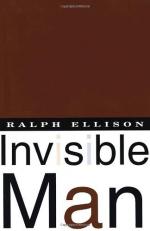|
This section contains 283 words (approx. 1 page at 400 words per page) |

|
Invisible Man Summary & Study Guide Description
Invisible Man Summary & Study Guide includes comprehensive information and analysis to help you understand the book. This study guide contains the following sections:
This detailed literature summary also contains Bibliography and a Free Quiz on Invisible Man by Ralph Ellison.
At its appearance in 1952, Invisible Man was immediately hailed as a masterpiece A work both epic and richly comic, It won the National Book Award for its author, Ralph Ellison. Invisible Man has been translated into fourteen languages and has never been out of print. A 1965 Book Week poll of two hundred writers and critics selected it as the most distinguished novel of the previous twenty years. Written in the style of a bildungsroman, or novel of education, the book chronicles the sometimes absurd adventures of a young black man whose successful search for identity ends with the realization that he is invisible to the white world. Invisible Man is structurally complex and densely symbolic; some critics, in fact, faulted it for what they saw as literary excess. A major controversy centered on the book's intended audience: some black critics argued that it was or should have been a "race" novel, while white critics were relieved that It was not. It also aroused the ire of black nationalists for sacrificing the broader concerns of black nationhood in the defense of a narrow individualism. This contentiousness dissipated over time, however, and the novel's enduring qualities are now undisputed. Invisible Man deals with themes of individuality, identity, history, and responsibility. The protagonist is repeatedly exhorted to look beneath the surface of things. Although Ellison freely acknowledged his debt to both European and African American literary traditions, he used an astonishing range of African American folk forms in constructing his protagonist's universe.
Critics agree that the influence of Invisible Man on American literature in general, and its role in bringing the blues and folklore into the mainstream of black experience in particular, is incalculable.
Read more from the Study Guide
|
This section contains 283 words (approx. 1 page at 400 words per page) |

|



